Case Study Review: Wound Management and Pain Management
VerifiedAdded on 2023/01/18
|11
|2220
|45
AI Summary
This case study review focuses on wound management and pain management. It includes a holistic assessment of two patients, principles of wound management, evaluation of wounds, expected healing process, wound management plan, health education to the patient, and pain management strategies. The case study covers various types of wounds, including diabetic foot ulcers, arterial ulcers, pressure ulcers, and malignant wounds. It also discusses the importance of proper wound care and pain management techniques.
Contribute Materials
Your contribution can guide someone’s learning journey. Share your
documents today.
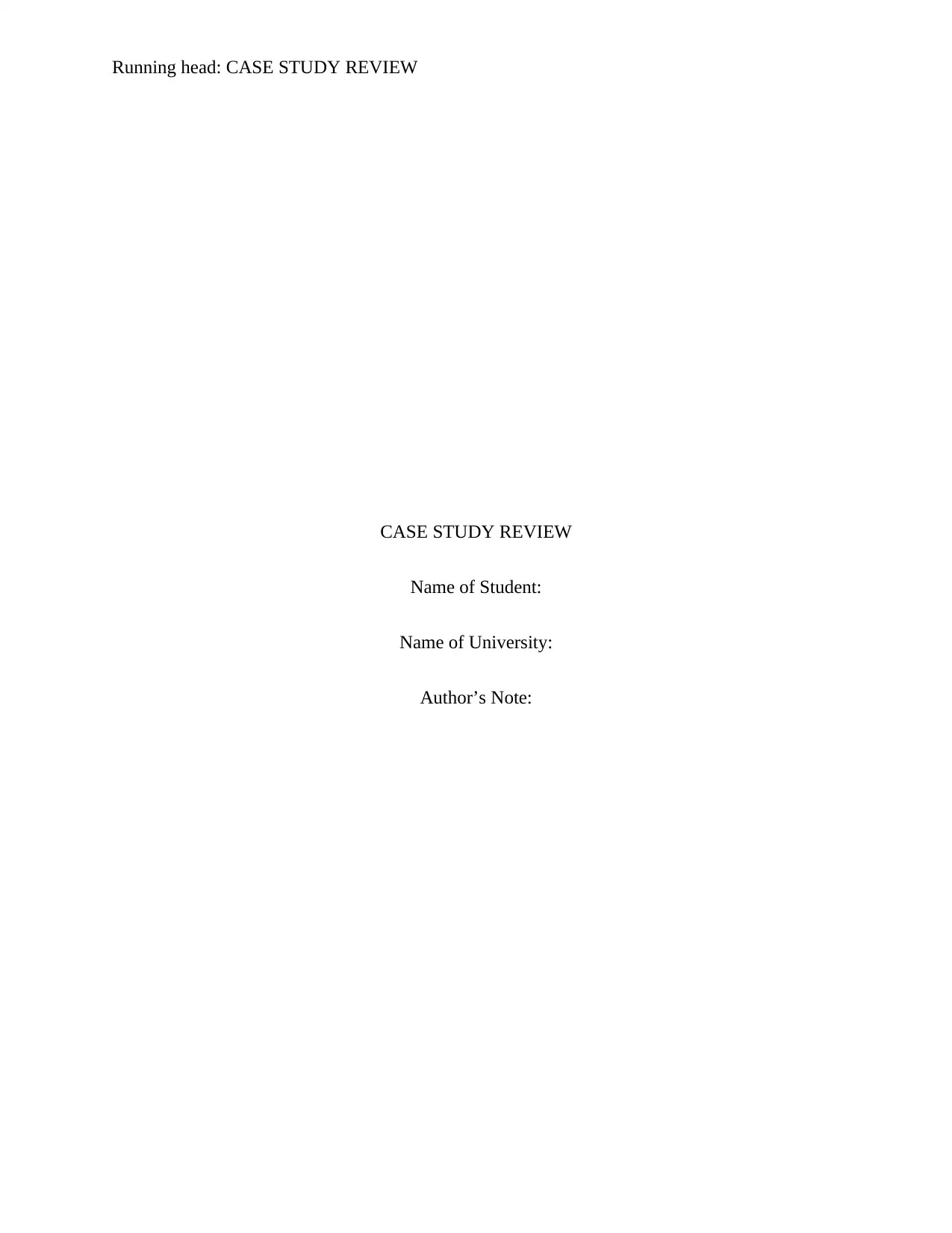
Running head: CASE STUDY REVIEW
CASE STUDY REVIEW
Name of Student:
Name of University:
Author’s Note:
CASE STUDY REVIEW
Name of Student:
Name of University:
Author’s Note:
Secure Best Marks with AI Grader
Need help grading? Try our AI Grader for instant feedback on your assignments.
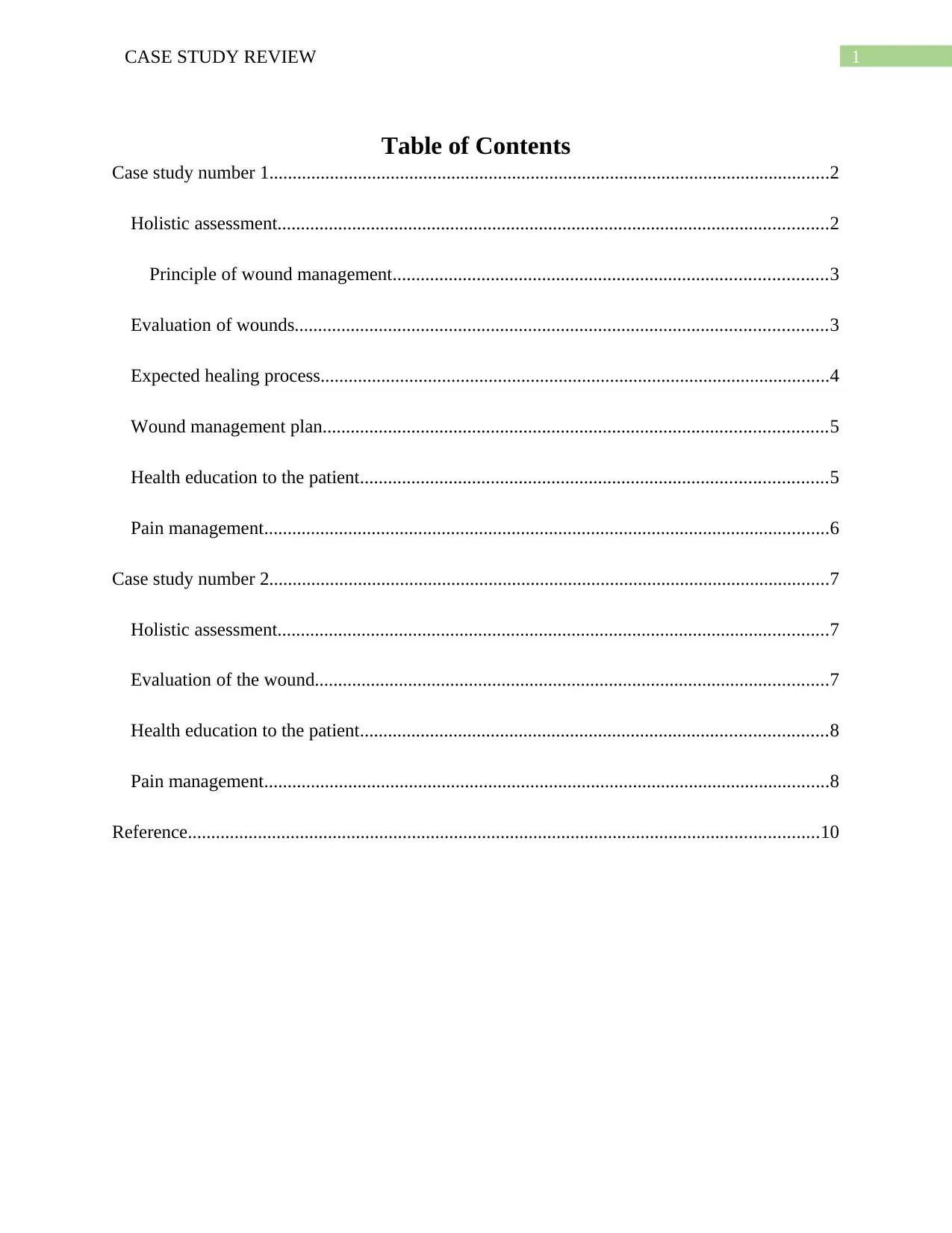
1CASE STUDY REVIEW
Table of Contents
Case study number 1........................................................................................................................2
Holistic assessment......................................................................................................................2
Principle of wound management.............................................................................................3
Evaluation of wounds..................................................................................................................3
Expected healing process.............................................................................................................4
Wound management plan............................................................................................................5
Health education to the patient....................................................................................................5
Pain management.........................................................................................................................6
Case study number 2........................................................................................................................7
Holistic assessment......................................................................................................................7
Evaluation of the wound..............................................................................................................7
Health education to the patient....................................................................................................8
Pain management.........................................................................................................................8
Reference.......................................................................................................................................10
Table of Contents
Case study number 1........................................................................................................................2
Holistic assessment......................................................................................................................2
Principle of wound management.............................................................................................3
Evaluation of wounds..................................................................................................................3
Expected healing process.............................................................................................................4
Wound management plan............................................................................................................5
Health education to the patient....................................................................................................5
Pain management.........................................................................................................................6
Case study number 2........................................................................................................................7
Holistic assessment......................................................................................................................7
Evaluation of the wound..............................................................................................................7
Health education to the patient....................................................................................................8
Pain management.........................................................................................................................8
Reference.......................................................................................................................................10

2CASE STUDY REVIEW
Case study number 1.
Holistic assessment
Mr will Jackson is 77 year old patient who is suffering from rectal cancer since 5 years.
He has related issue of ETOH, COPD, GORD, T2DM and postural hypotension. He had
undergone CABG because of heart disease. He was hospitalized for severe pain, management of
wound and SOB. On examination, it was noted that he had stage three pressure ulcer on sacrum
bone. He had arterial ulcer situated at right lower leg and diabetic ulcer on left toe. He also
suffered third degree burn which happened on his left arm.
Diabetic Foot Ulcer- Diabetes foot ulcer are the sores which is caused by complication of
neuropathic and arteriopathy. There is nerve damage in the foot which make the person loss in
sensation. Jackson is having foot ulcer on his left toe (Armstrong, Boulton & Bus, 2017).
Arterial Foot Ulcer- It is sore caused by poor perfusion of blood lower extremities. This leave
the skin deprive of oxygen leading to damage of arteries and open wound. The ulcer is located in
the lower right leg of the patient. The wound swab has reflected its infection.
Pressure Ulcer- They are skin injury due to prolonged pressure on particular body part. The
patient is having stage 3 ulcer on sacrum bone. As the patient was diabetic, has worsen the
pressure ulcer
Second Degree Burn- The skin gets burned due to extreme heat where the epidermis get badly
affected. Patient got this burn because hot coffee got spilled over his left arm.
Principle of wound management
The principle underline by following points:
Case study number 1.
Holistic assessment
Mr will Jackson is 77 year old patient who is suffering from rectal cancer since 5 years.
He has related issue of ETOH, COPD, GORD, T2DM and postural hypotension. He had
undergone CABG because of heart disease. He was hospitalized for severe pain, management of
wound and SOB. On examination, it was noted that he had stage three pressure ulcer on sacrum
bone. He had arterial ulcer situated at right lower leg and diabetic ulcer on left toe. He also
suffered third degree burn which happened on his left arm.
Diabetic Foot Ulcer- Diabetes foot ulcer are the sores which is caused by complication of
neuropathic and arteriopathy. There is nerve damage in the foot which make the person loss in
sensation. Jackson is having foot ulcer on his left toe (Armstrong, Boulton & Bus, 2017).
Arterial Foot Ulcer- It is sore caused by poor perfusion of blood lower extremities. This leave
the skin deprive of oxygen leading to damage of arteries and open wound. The ulcer is located in
the lower right leg of the patient. The wound swab has reflected its infection.
Pressure Ulcer- They are skin injury due to prolonged pressure on particular body part. The
patient is having stage 3 ulcer on sacrum bone. As the patient was diabetic, has worsen the
pressure ulcer
Second Degree Burn- The skin gets burned due to extreme heat where the epidermis get badly
affected. Patient got this burn because hot coffee got spilled over his left arm.
Principle of wound management
The principle underline by following points:
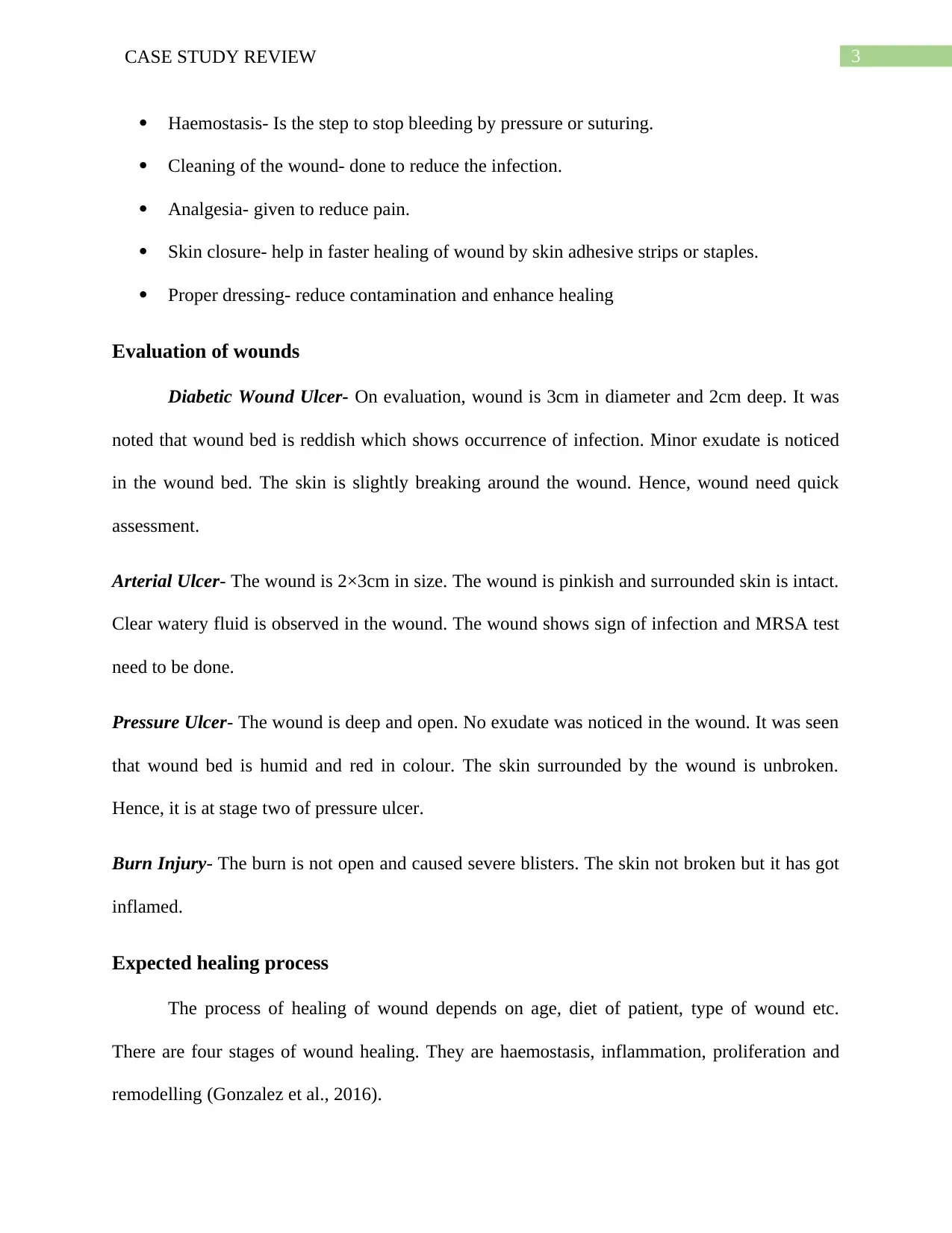
3CASE STUDY REVIEW
Haemostasis- Is the step to stop bleeding by pressure or suturing.
Cleaning of the wound- done to reduce the infection.
Analgesia- given to reduce pain.
Skin closure- help in faster healing of wound by skin adhesive strips or staples.
Proper dressing- reduce contamination and enhance healing
Evaluation of wounds
Diabetic Wound Ulcer- On evaluation, wound is 3cm in diameter and 2cm deep. It was
noted that wound bed is reddish which shows occurrence of infection. Minor exudate is noticed
in the wound bed. The skin is slightly breaking around the wound. Hence, wound need quick
assessment.
Arterial Ulcer- The wound is 2×3cm in size. The wound is pinkish and surrounded skin is intact.
Clear watery fluid is observed in the wound. The wound shows sign of infection and MRSA test
need to be done.
Pressure Ulcer- The wound is deep and open. No exudate was noticed in the wound. It was seen
that wound bed is humid and red in colour. The skin surrounded by the wound is unbroken.
Hence, it is at stage two of pressure ulcer.
Burn Injury- The burn is not open and caused severe blisters. The skin not broken but it has got
inflamed.
Expected healing process
The process of healing of wound depends on age, diet of patient, type of wound etc.
There are four stages of wound healing. They are haemostasis, inflammation, proliferation and
remodelling (Gonzalez et al., 2016).
Haemostasis- Is the step to stop bleeding by pressure or suturing.
Cleaning of the wound- done to reduce the infection.
Analgesia- given to reduce pain.
Skin closure- help in faster healing of wound by skin adhesive strips or staples.
Proper dressing- reduce contamination and enhance healing
Evaluation of wounds
Diabetic Wound Ulcer- On evaluation, wound is 3cm in diameter and 2cm deep. It was
noted that wound bed is reddish which shows occurrence of infection. Minor exudate is noticed
in the wound bed. The skin is slightly breaking around the wound. Hence, wound need quick
assessment.
Arterial Ulcer- The wound is 2×3cm in size. The wound is pinkish and surrounded skin is intact.
Clear watery fluid is observed in the wound. The wound shows sign of infection and MRSA test
need to be done.
Pressure Ulcer- The wound is deep and open. No exudate was noticed in the wound. It was seen
that wound bed is humid and red in colour. The skin surrounded by the wound is unbroken.
Hence, it is at stage two of pressure ulcer.
Burn Injury- The burn is not open and caused severe blisters. The skin not broken but it has got
inflamed.
Expected healing process
The process of healing of wound depends on age, diet of patient, type of wound etc.
There are four stages of wound healing. They are haemostasis, inflammation, proliferation and
remodelling (Gonzalez et al., 2016).
Secure Best Marks with AI Grader
Need help grading? Try our AI Grader for instant feedback on your assignments.
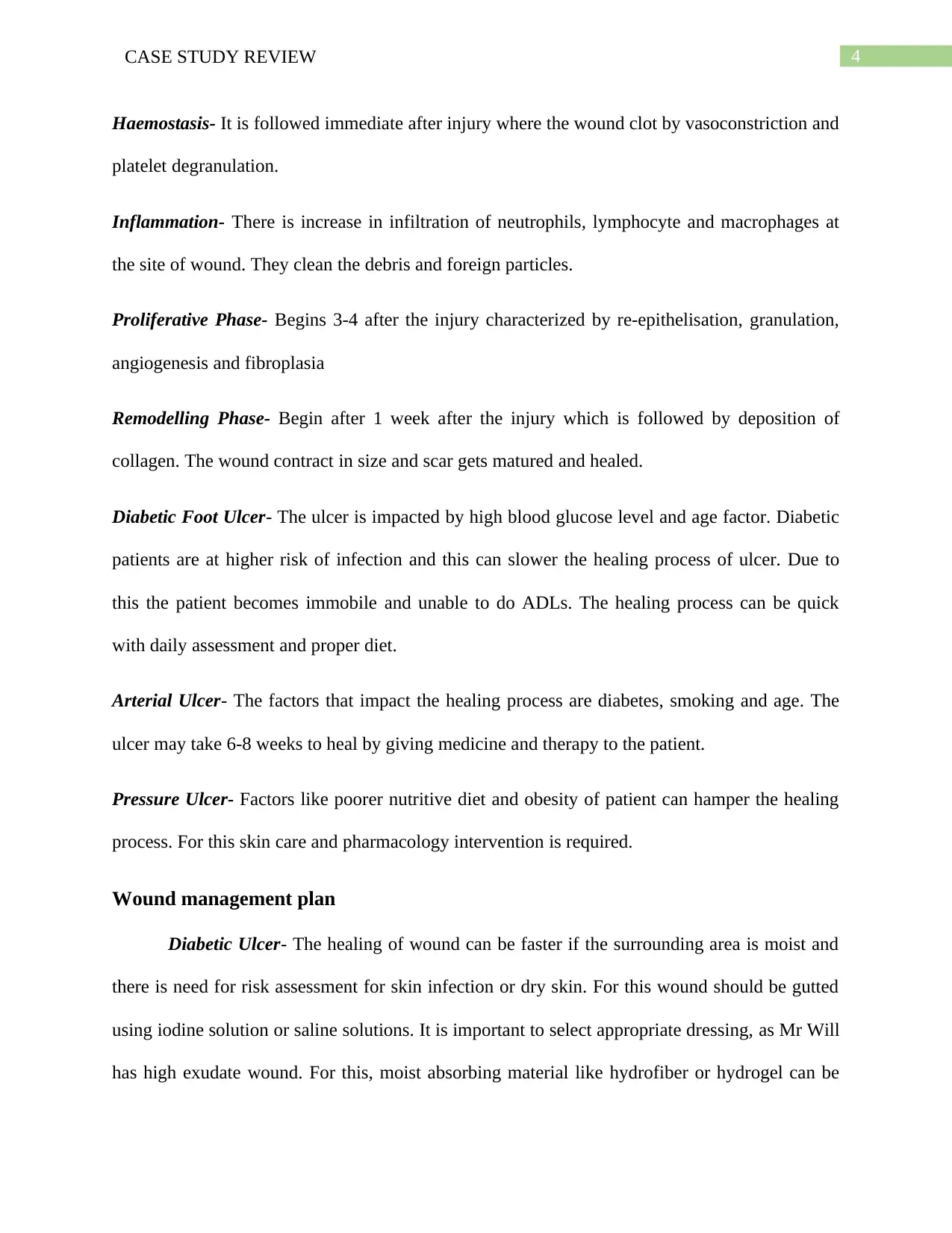
4CASE STUDY REVIEW
Haemostasis- It is followed immediate after injury where the wound clot by vasoconstriction and
platelet degranulation.
Inflammation- There is increase in infiltration of neutrophils, lymphocyte and macrophages at
the site of wound. They clean the debris and foreign particles.
Proliferative Phase- Begins 3-4 after the injury characterized by re-epithelisation, granulation,
angiogenesis and fibroplasia
Remodelling Phase- Begin after 1 week after the injury which is followed by deposition of
collagen. The wound contract in size and scar gets matured and healed.
Diabetic Foot Ulcer- The ulcer is impacted by high blood glucose level and age factor. Diabetic
patients are at higher risk of infection and this can slower the healing process of ulcer. Due to
this the patient becomes immobile and unable to do ADLs. The healing process can be quick
with daily assessment and proper diet.
Arterial Ulcer- The factors that impact the healing process are diabetes, smoking and age. The
ulcer may take 6-8 weeks to heal by giving medicine and therapy to the patient.
Pressure Ulcer- Factors like poorer nutritive diet and obesity of patient can hamper the healing
process. For this skin care and pharmacology intervention is required.
Wound management plan
Diabetic Ulcer- The healing of wound can be faster if the surrounding area is moist and
there is need for risk assessment for skin infection or dry skin. For this wound should be gutted
using iodine solution or saline solutions. It is important to select appropriate dressing, as Mr Will
has high exudate wound. For this, moist absorbing material like hydrofiber or hydrogel can be
Haemostasis- It is followed immediate after injury where the wound clot by vasoconstriction and
platelet degranulation.
Inflammation- There is increase in infiltration of neutrophils, lymphocyte and macrophages at
the site of wound. They clean the debris and foreign particles.
Proliferative Phase- Begins 3-4 after the injury characterized by re-epithelisation, granulation,
angiogenesis and fibroplasia
Remodelling Phase- Begin after 1 week after the injury which is followed by deposition of
collagen. The wound contract in size and scar gets matured and healed.
Diabetic Foot Ulcer- The ulcer is impacted by high blood glucose level and age factor. Diabetic
patients are at higher risk of infection and this can slower the healing process of ulcer. Due to
this the patient becomes immobile and unable to do ADLs. The healing process can be quick
with daily assessment and proper diet.
Arterial Ulcer- The factors that impact the healing process are diabetes, smoking and age. The
ulcer may take 6-8 weeks to heal by giving medicine and therapy to the patient.
Pressure Ulcer- Factors like poorer nutritive diet and obesity of patient can hamper the healing
process. For this skin care and pharmacology intervention is required.
Wound management plan
Diabetic Ulcer- The healing of wound can be faster if the surrounding area is moist and
there is need for risk assessment for skin infection or dry skin. For this wound should be gutted
using iodine solution or saline solutions. It is important to select appropriate dressing, as Mr Will
has high exudate wound. For this, moist absorbing material like hydrofiber or hydrogel can be
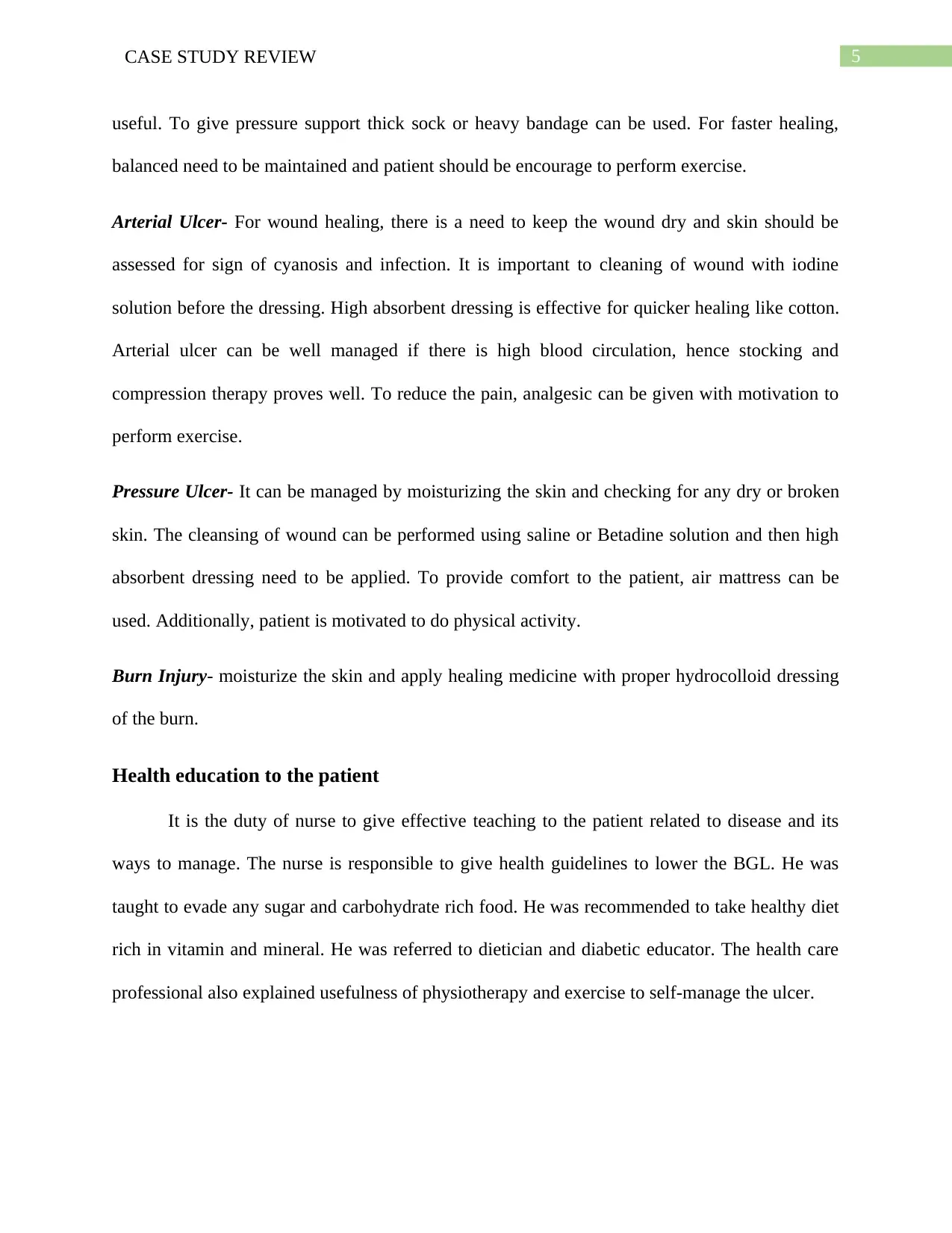
5CASE STUDY REVIEW
useful. To give pressure support thick sock or heavy bandage can be used. For faster healing,
balanced need to be maintained and patient should be encourage to perform exercise.
Arterial Ulcer- For wound healing, there is a need to keep the wound dry and skin should be
assessed for sign of cyanosis and infection. It is important to cleaning of wound with iodine
solution before the dressing. High absorbent dressing is effective for quicker healing like cotton.
Arterial ulcer can be well managed if there is high blood circulation, hence stocking and
compression therapy proves well. To reduce the pain, analgesic can be given with motivation to
perform exercise.
Pressure Ulcer- It can be managed by moisturizing the skin and checking for any dry or broken
skin. The cleansing of wound can be performed using saline or Betadine solution and then high
absorbent dressing need to be applied. To provide comfort to the patient, air mattress can be
used. Additionally, patient is motivated to do physical activity.
Burn Injury- moisturize the skin and apply healing medicine with proper hydrocolloid dressing
of the burn.
Health education to the patient
It is the duty of nurse to give effective teaching to the patient related to disease and its
ways to manage. The nurse is responsible to give health guidelines to lower the BGL. He was
taught to evade any sugar and carbohydrate rich food. He was recommended to take healthy diet
rich in vitamin and mineral. He was referred to dietician and diabetic educator. The health care
professional also explained usefulness of physiotherapy and exercise to self-manage the ulcer.
useful. To give pressure support thick sock or heavy bandage can be used. For faster healing,
balanced need to be maintained and patient should be encourage to perform exercise.
Arterial Ulcer- For wound healing, there is a need to keep the wound dry and skin should be
assessed for sign of cyanosis and infection. It is important to cleaning of wound with iodine
solution before the dressing. High absorbent dressing is effective for quicker healing like cotton.
Arterial ulcer can be well managed if there is high blood circulation, hence stocking and
compression therapy proves well. To reduce the pain, analgesic can be given with motivation to
perform exercise.
Pressure Ulcer- It can be managed by moisturizing the skin and checking for any dry or broken
skin. The cleansing of wound can be performed using saline or Betadine solution and then high
absorbent dressing need to be applied. To provide comfort to the patient, air mattress can be
used. Additionally, patient is motivated to do physical activity.
Burn Injury- moisturize the skin and apply healing medicine with proper hydrocolloid dressing
of the burn.
Health education to the patient
It is the duty of nurse to give effective teaching to the patient related to disease and its
ways to manage. The nurse is responsible to give health guidelines to lower the BGL. He was
taught to evade any sugar and carbohydrate rich food. He was recommended to take healthy diet
rich in vitamin and mineral. He was referred to dietician and diabetic educator. The health care
professional also explained usefulness of physiotherapy and exercise to self-manage the ulcer.
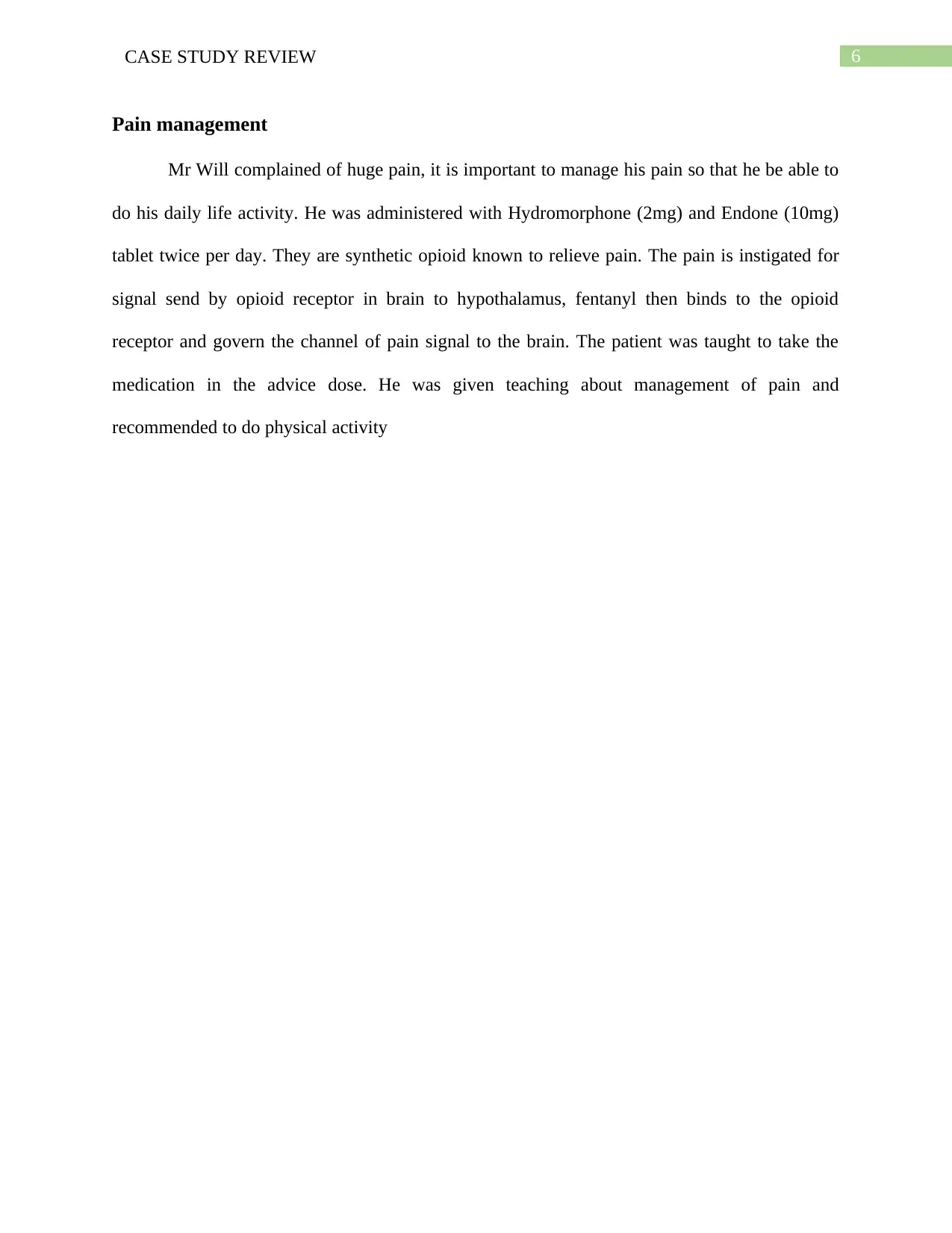
6CASE STUDY REVIEW
Pain management
Mr Will complained of huge pain, it is important to manage his pain so that he be able to
do his daily life activity. He was administered with Hydromorphone (2mg) and Endone (10mg)
tablet twice per day. They are synthetic opioid known to relieve pain. The pain is instigated for
signal send by opioid receptor in brain to hypothalamus, fentanyl then binds to the opioid
receptor and govern the channel of pain signal to the brain. The patient was taught to take the
medication in the advice dose. He was given teaching about management of pain and
recommended to do physical activity
Pain management
Mr Will complained of huge pain, it is important to manage his pain so that he be able to
do his daily life activity. He was administered with Hydromorphone (2mg) and Endone (10mg)
tablet twice per day. They are synthetic opioid known to relieve pain. The pain is instigated for
signal send by opioid receptor in brain to hypothalamus, fentanyl then binds to the opioid
receptor and govern the channel of pain signal to the brain. The patient was taught to take the
medication in the advice dose. He was given teaching about management of pain and
recommended to do physical activity
Paraphrase This Document
Need a fresh take? Get an instant paraphrase of this document with our AI Paraphraser
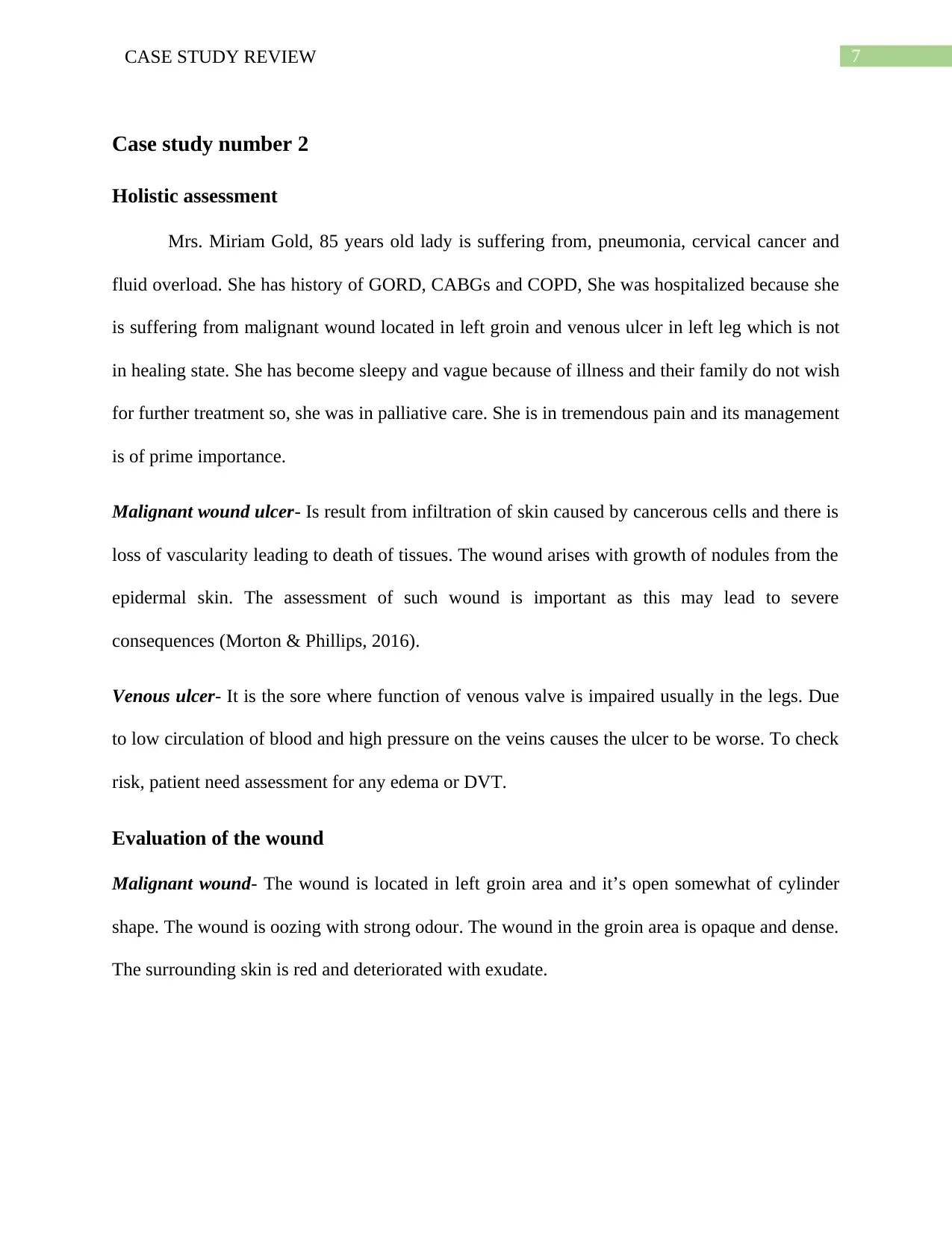
7CASE STUDY REVIEW
Case study number 2
Holistic assessment
Mrs. Miriam Gold, 85 years old lady is suffering from, pneumonia, cervical cancer and
fluid overload. She has history of GORD, CABGs and COPD, She was hospitalized because she
is suffering from malignant wound located in left groin and venous ulcer in left leg which is not
in healing state. She has become sleepy and vague because of illness and their family do not wish
for further treatment so, she was in palliative care. She is in tremendous pain and its management
is of prime importance.
Malignant wound ulcer- Is result from infiltration of skin caused by cancerous cells and there is
loss of vascularity leading to death of tissues. The wound arises with growth of nodules from the
epidermal skin. The assessment of such wound is important as this may lead to severe
consequences (Morton & Phillips, 2016).
Venous ulcer- It is the sore where function of venous valve is impaired usually in the legs. Due
to low circulation of blood and high pressure on the veins causes the ulcer to be worse. To check
risk, patient need assessment for any edema or DVT.
Evaluation of the wound
Malignant wound- The wound is located in left groin area and it’s open somewhat of cylinder
shape. The wound is oozing with strong odour. The wound in the groin area is opaque and dense.
The surrounding skin is red and deteriorated with exudate.
Case study number 2
Holistic assessment
Mrs. Miriam Gold, 85 years old lady is suffering from, pneumonia, cervical cancer and
fluid overload. She has history of GORD, CABGs and COPD, She was hospitalized because she
is suffering from malignant wound located in left groin and venous ulcer in left leg which is not
in healing state. She has become sleepy and vague because of illness and their family do not wish
for further treatment so, she was in palliative care. She is in tremendous pain and its management
is of prime importance.
Malignant wound ulcer- Is result from infiltration of skin caused by cancerous cells and there is
loss of vascularity leading to death of tissues. The wound arises with growth of nodules from the
epidermal skin. The assessment of such wound is important as this may lead to severe
consequences (Morton & Phillips, 2016).
Venous ulcer- It is the sore where function of venous valve is impaired usually in the legs. Due
to low circulation of blood and high pressure on the veins causes the ulcer to be worse. To check
risk, patient need assessment for any edema or DVT.
Evaluation of the wound
Malignant wound- The wound is located in left groin area and it’s open somewhat of cylinder
shape. The wound is oozing with strong odour. The wound in the groin area is opaque and dense.
The surrounding skin is red and deteriorated with exudate.
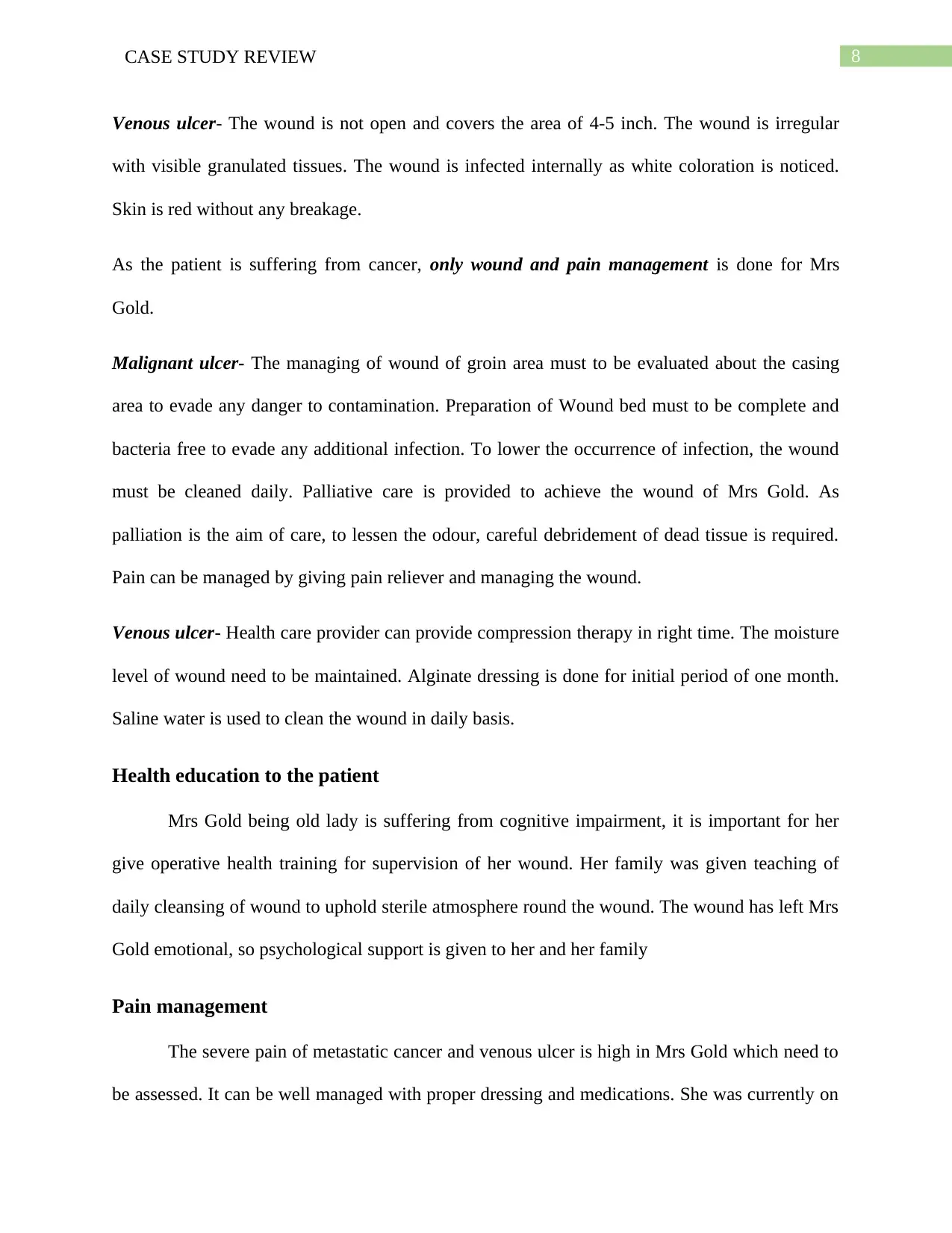
8CASE STUDY REVIEW
Venous ulcer- The wound is not open and covers the area of 4-5 inch. The wound is irregular
with visible granulated tissues. The wound is infected internally as white coloration is noticed.
Skin is red without any breakage.
As the patient is suffering from cancer, only wound and pain management is done for Mrs
Gold.
Malignant ulcer- The managing of wound of groin area must to be evaluated about the casing
area to evade any danger to contamination. Preparation of Wound bed must to be complete and
bacteria free to evade any additional infection. To lower the occurrence of infection, the wound
must be cleaned daily. Palliative care is provided to achieve the wound of Mrs Gold. As
palliation is the aim of care, to lessen the odour, careful debridement of dead tissue is required.
Pain can be managed by giving pain reliever and managing the wound.
Venous ulcer- Health care provider can provide compression therapy in right time. The moisture
level of wound need to be maintained. Alginate dressing is done for initial period of one month.
Saline water is used to clean the wound in daily basis.
Health education to the patient
Mrs Gold being old lady is suffering from cognitive impairment, it is important for her
give operative health training for supervision of her wound. Her family was given teaching of
daily cleansing of wound to uphold sterile atmosphere round the wound. The wound has left Mrs
Gold emotional, so psychological support is given to her and her family
Pain management
The severe pain of metastatic cancer and venous ulcer is high in Mrs Gold which need to
be assessed. It can be well managed with proper dressing and medications. She was currently on
Venous ulcer- The wound is not open and covers the area of 4-5 inch. The wound is irregular
with visible granulated tissues. The wound is infected internally as white coloration is noticed.
Skin is red without any breakage.
As the patient is suffering from cancer, only wound and pain management is done for Mrs
Gold.
Malignant ulcer- The managing of wound of groin area must to be evaluated about the casing
area to evade any danger to contamination. Preparation of Wound bed must to be complete and
bacteria free to evade any additional infection. To lower the occurrence of infection, the wound
must be cleaned daily. Palliative care is provided to achieve the wound of Mrs Gold. As
palliation is the aim of care, to lessen the odour, careful debridement of dead tissue is required.
Pain can be managed by giving pain reliever and managing the wound.
Venous ulcer- Health care provider can provide compression therapy in right time. The moisture
level of wound need to be maintained. Alginate dressing is done for initial period of one month.
Saline water is used to clean the wound in daily basis.
Health education to the patient
Mrs Gold being old lady is suffering from cognitive impairment, it is important for her
give operative health training for supervision of her wound. Her family was given teaching of
daily cleansing of wound to uphold sterile atmosphere round the wound. The wound has left Mrs
Gold emotional, so psychological support is given to her and her family
Pain management
The severe pain of metastatic cancer and venous ulcer is high in Mrs Gold which need to
be assessed. It can be well managed with proper dressing and medications. She was currently on
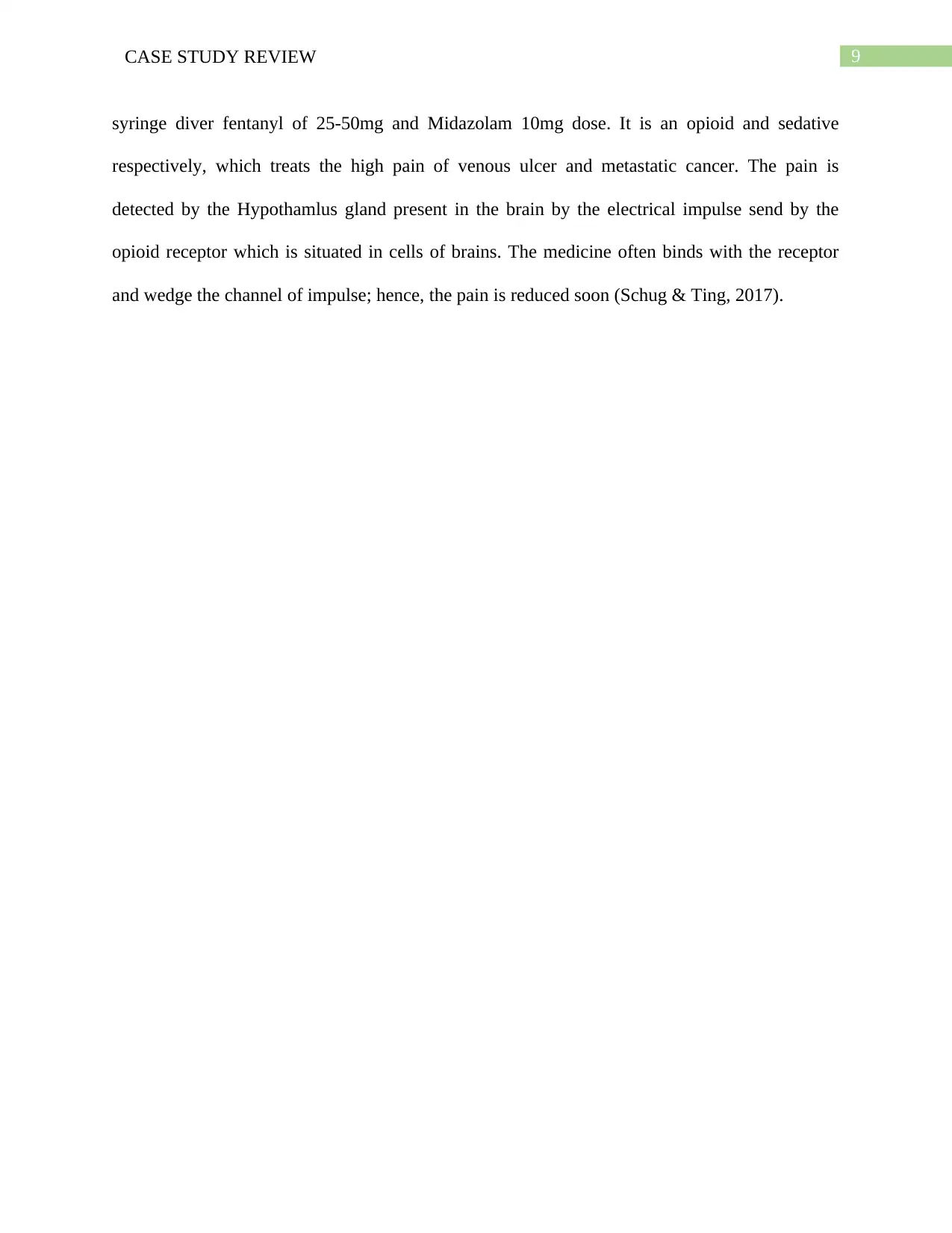
9CASE STUDY REVIEW
syringe diver fentanyl of 25-50mg and Midazolam 10mg dose. It is an opioid and sedative
respectively, which treats the high pain of venous ulcer and metastatic cancer. The pain is
detected by the Hypothamlus gland present in the brain by the electrical impulse send by the
opioid receptor which is situated in cells of brains. The medicine often binds with the receptor
and wedge the channel of impulse; hence, the pain is reduced soon (Schug & Ting, 2017).
syringe diver fentanyl of 25-50mg and Midazolam 10mg dose. It is an opioid and sedative
respectively, which treats the high pain of venous ulcer and metastatic cancer. The pain is
detected by the Hypothamlus gland present in the brain by the electrical impulse send by the
opioid receptor which is situated in cells of brains. The medicine often binds with the receptor
and wedge the channel of impulse; hence, the pain is reduced soon (Schug & Ting, 2017).
Secure Best Marks with AI Grader
Need help grading? Try our AI Grader for instant feedback on your assignments.
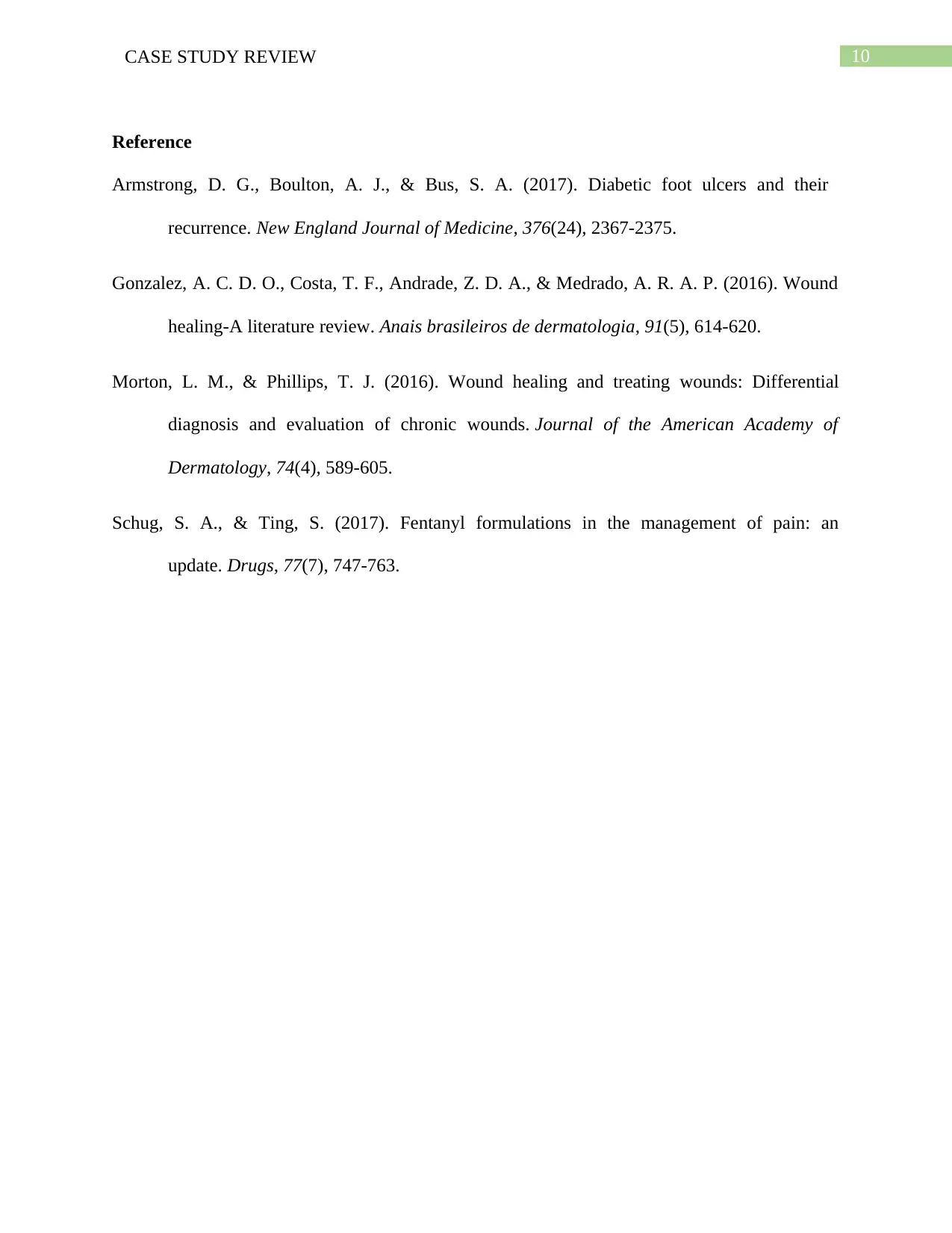
10CASE STUDY REVIEW
Reference
Armstrong, D. G., Boulton, A. J., & Bus, S. A. (2017). Diabetic foot ulcers and their
recurrence. New England Journal of Medicine, 376(24), 2367-2375.
Gonzalez, A. C. D. O., Costa, T. F., Andrade, Z. D. A., & Medrado, A. R. A. P. (2016). Wound
healing-A literature review. Anais brasileiros de dermatologia, 91(5), 614-620.
Morton, L. M., & Phillips, T. J. (2016). Wound healing and treating wounds: Differential
diagnosis and evaluation of chronic wounds. Journal of the American Academy of
Dermatology, 74(4), 589-605.
Schug, S. A., & Ting, S. (2017). Fentanyl formulations in the management of pain: an
update. Drugs, 77(7), 747-763.
Reference
Armstrong, D. G., Boulton, A. J., & Bus, S. A. (2017). Diabetic foot ulcers and their
recurrence. New England Journal of Medicine, 376(24), 2367-2375.
Gonzalez, A. C. D. O., Costa, T. F., Andrade, Z. D. A., & Medrado, A. R. A. P. (2016). Wound
healing-A literature review. Anais brasileiros de dermatologia, 91(5), 614-620.
Morton, L. M., & Phillips, T. J. (2016). Wound healing and treating wounds: Differential
diagnosis and evaluation of chronic wounds. Journal of the American Academy of
Dermatology, 74(4), 589-605.
Schug, S. A., & Ting, S. (2017). Fentanyl formulations in the management of pain: an
update. Drugs, 77(7), 747-763.
1 out of 11
Related Documents
Your All-in-One AI-Powered Toolkit for Academic Success.
+13062052269
info@desklib.com
Available 24*7 on WhatsApp / Email
![[object Object]](/_next/static/media/star-bottom.7253800d.svg)
Unlock your academic potential
© 2024 | Zucol Services PVT LTD | All rights reserved.





